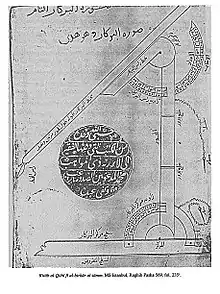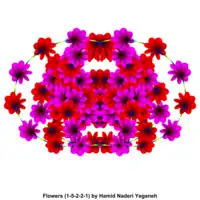Kushyar Gilani
Abul-Hasan Kūshyār ibn Labbān ibn Bashahri Daylami (971–1029), also known as Kūshyār Daylami (Persian: کوشیار دیلمی), was an Iranian[1][2] mathematician, geographer, and astronomer from Daylam, south of the Caspian Sea, Iran.
Kushyar Gilani | |
|---|---|
کوشیار دیلمی | |
| Born | 971 |
| Died | 1029 |
| Academic work | |
| Era | Islamic Golden Age |
| Main interests | Astronomy, mathematics, geography |
Career
Kūshyār Daylami's main work was probably done about the beginning of the 11th century, and seems to have taken an important part in the elaboration of trigonometry. He continued the investigations of the 10th century mathematician and astronomer Abul Wáfa, and devoted much space to this in his zīj (book of astronomical tables) az-Zīj al-Jamī wal-Baligh ("The Comprehensive and Mature Tables"), which incorporated the improved values of the planetary apogees observed by al-Battani.[3] The tables were translated into the Persian language before the end of the century. He wrote also an astrological introduction and an arithmetic treatise Kitab fi usul hisab al-hind (Principles of Hindu Reckoning, that is extant in both Arabic and Hebrew).
Kūshyār Daylami's pupils included the Persian mathematician Al-Nasawi. Kūshyār Daylami is thought to have died in Baghdad.
References
- Hockey, Thomas (2014). Biographical encyclopedia of astronomers. New York: Springer. p. 1074. ISBN 9781441999184.
Kushyar ibn Labban was an eminent Iranian astronomer known for his work on astronomical handbooks (zijes) in addition to his work in mathematics and astrology.
- Selin, Helaine (2008). Encyclopaedia of the history of science, technology, and medicine in non-western cultures. Berlin New York: Springer. p. 241. ISBN 9781402049606.
Another important early treatise that publicized decimal numbers was Iranian mathematician and astronomer Kūshyār ibn Labbān's (fl. 1000) Kitāb fī usūl hisāb al-hind (Principles of Hindu Reckoning), a leading arithmetic textbook.
- E. S. Kennedy, A Survey of Islamic Astronomical Tables, (Transactions of the American Philosophical Society, New Series, 46, 2), Philadelphia, 1956, pp. 3, 34-5.
Further reading
- O'Connor, J.J.; Robertson, E.F. (2003). "Kushyar ibn Labban". MacTutor. University of St Andrews. Retrieved 7 March 2023.
- Suter, Heinrich (1900). Die Mathematiker und Astronomen der Araber und ihre Werke (in German). Leipzig: Teubner. OCLC 230703086.
- Bagheri, Mohammad (2007). "Ibn Labbān, Kūshyār: Kiyā Abū al‐Ḥasan Kūshyār ibn Labbān Bāshahrī al‐Jīlī (Gīlānī)". In Thomas Hockey; et al. (eds.). The Biographical Encyclopedia of Astronomers. New York: Springer. pp. 560–1. ISBN 978-0-387-31022-0. (PDF version)

